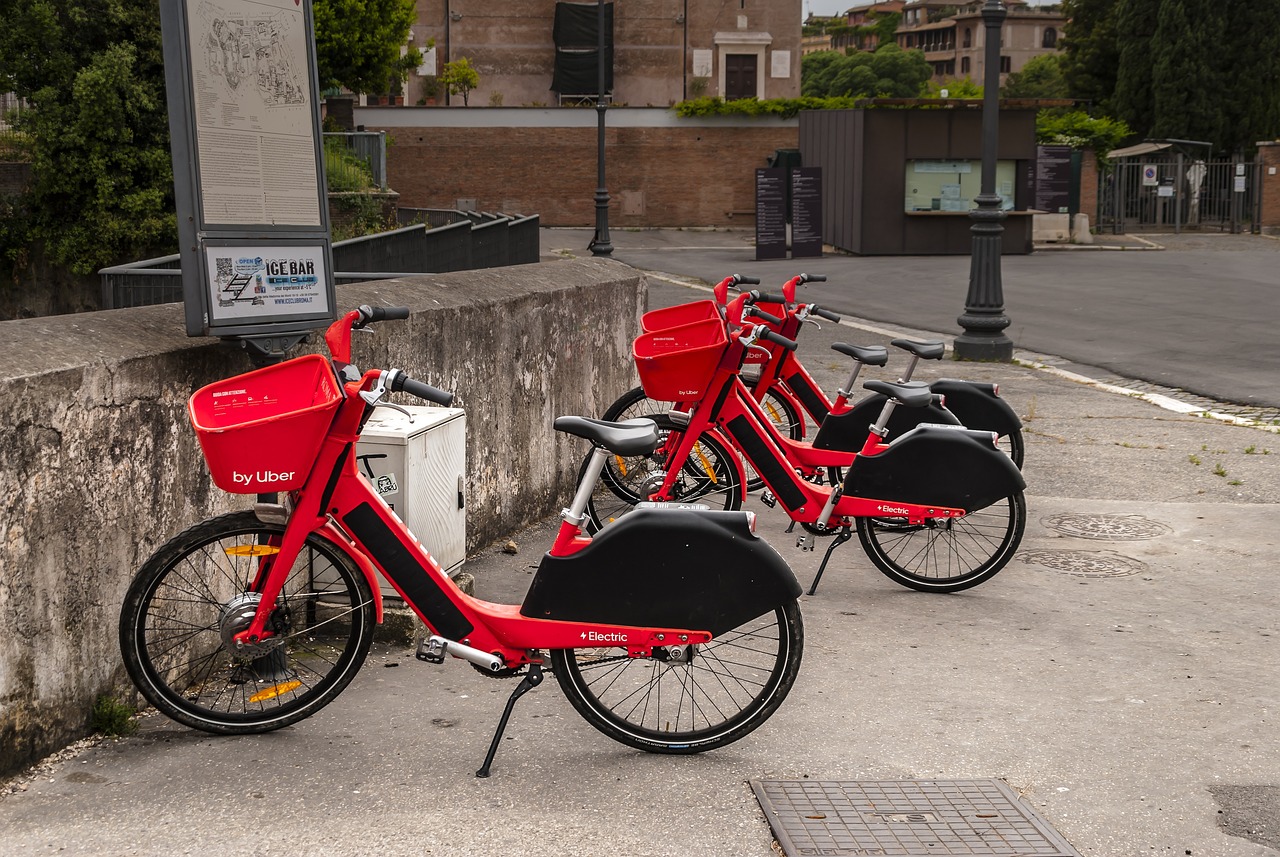In an age where urban pollution is becoming a pressing concern, innovative solutions like bike-sharing programs are emerging as powerful allies in the fight against environmental degradation. These systems not only provide a convenient mode of transportation but also play a crucial role in reducing the carbon footprint of cities. Imagine a bustling metropolis where the air is crisp, the streets are filled with cyclists instead of cars, and the sounds of honking horns are replaced by the gentle whir of bicycle wheels. This vision is becoming a reality in many urban areas thanks to the rise of bike-sharing initiatives.
Bike-sharing programs are designed to offer an easily accessible and cost-effective alternative to traditional motorized transport. Users can rent bicycles from various stations scattered throughout the city, allowing for quick and flexible travel. This convenience encourages more people to ditch their cars for a healthier and more sustainable option. With each pedal stroke, individuals contribute to a collective effort that not only enhances their personal well-being but also fosters a cleaner environment.
The impact of bike-sharing on urban pollution is profound. By replacing short car trips with cycling, these programs significantly reduce greenhouse gas emissions and lower air pollution levels. It's like replacing a noisy, gas-guzzling engine with the quiet hum of human-powered transport. When you consider that a significant portion of urban trips are less than three miles, the potential for emissions reduction becomes clear. In fact, studies have shown that cities with robust bike-sharing systems can see a marked decrease in the use of fossil fuels, leading to cleaner air and healthier residents.
Moreover, the benefits of bike-sharing extend beyond immediate pollution reduction. Long-term, these programs can influence urban planning and encourage sustainable practices among both residents and policymakers. Cities that invest in bike-sharing infrastructure often see a shift in public perception regarding transportation, leading to increased support for cycling-friendly policies and investments in pedestrian-friendly spaces.
In conclusion, bike-sharing programs are not just a trend; they are a vital component of a sustainable urban future. By promoting cycling as a primary mode of transport, cities can significantly reduce pollution levels, improve public health, and create vibrant communities. As we embrace this shift, we are not only enhancing our quality of life but also taking crucial steps toward a greener planet.

Bike-sharing systems have revolutionized urban transportation by offering a convenient and eco-friendly alternative to traditional vehicles. Imagine a city where you can hop on a bike, pedal your way to your destination, and return it at a nearby station without the hassle of maintenance or parking. That's the beauty of bike-sharing! These systems operate through a network of bicycles that are available for short-term rentals, making them an attractive option for commuters, tourists, and anyone looking to reduce their carbon footprint.
The structure of bike-sharing programs typically involves a fleet of bicycles stationed at various docking points throughout a city. Users can easily locate and access these bikes using a mobile app or a membership card. This accessibility encourages more people to choose cycling over driving, especially for short trips. It's like having your own bike without the commitment of ownership!
One of the most appealing aspects of bike-sharing is its flexibility. Users can pick up a bike at one location and return it at another, allowing for seamless travel across urban landscapes. This feature is particularly beneficial in cities where traffic congestion and parking scarcity are common issues. By promoting cycling as a viable mode of transport, bike-sharing systems play a crucial role in reducing reliance on motor vehicles.
Moreover, bike-sharing programs often incorporate technology to enhance user experience. Smart bikes equipped with GPS and lock systems allow for easy tracking and management. Users can check bike availability in real-time, making it easier to plan their journeys. This tech-savvy approach not only attracts tech enthusiasts but also helps in optimizing the distribution of bikes across the city, ensuring that they are available where they are needed most.
In addition to their operational efficiency, bike-sharing systems have a social aspect. They foster a sense of community and encourage people to engage with their surroundings in a more active way. Riding a bike allows individuals to explore neighborhoods, discover local businesses, and connect with fellow cyclists. This interaction can lead to a more vibrant urban culture, where residents feel more invested in their city.
To summarize, bike-sharing systems are not just about providing bicycles; they are about creating a culture of sustainability and health. They offer an innovative solution to urban mobility challenges, making cities more accessible while promoting a greener environment. As more cities adopt these programs, the potential for reducing pollution and improving public health becomes even more significant.

Bike-sharing programs are not just a trendy way to get around; they are pivotal in creating a cleaner, more sustainable urban environment. By providing an accessible alternative to motorized transport, bike-sharing can significantly reduce urban pollution levels. Imagine a city where the air is fresher, the streets are quieter, and the overall quality of life is enhanced. This is the vision that bike-sharing helps to bring to life. By encouraging people to swap their cars for bicycles, these programs contribute to a range of environmental benefits that can transform urban landscapes.
One of the most significant impacts of bike-sharing is the reduction of greenhouse gas emissions. Cars are notorious for their carbon footprints, especially during short trips where the engine is less efficient. When individuals choose to bike instead of drive, they are not only reducing their own emissions but are also contributing to a collective effort to combat climate change. For instance, studies have shown that replacing just a few car trips per week with cycling can lead to a substantial decrease in carbon emissions. This is not just a drop in the bucket; it’s a wave of change that can ripple through entire communities.
When we talk about the carbon footprint, we often think of the cumulative impact of our daily choices. Bike-sharing programs encourage users to opt for cycling, which is a zero-emission mode of transport. This shift is particularly crucial in urban areas, where traffic congestion and pollution are at their peak. By replacing short car trips—often less than three miles—with cycling, cities can see a marked reduction in their overall carbon emissions. The transition to biking not only eases traffic but also promotes cleaner air, making cities more livable.
To understand the real impact of bike-sharing, let’s take a look at a comparative emissions analysis. Below is a table that outlines the average emissions produced by different modes of transportation:
| Transportation Mode | Average CO2 Emissions (g/km) |
|---|---|
| Car (Gasoline) | 120 |
| Bus | 80 |
| Bicycle | 0 |
As illustrated in the table, bicycles produce zero emissions during operation, while cars and buses contribute significantly to urban pollution. This stark contrast highlights the potential for bike-sharing programs to reduce overall emissions in cities. The more people who choose to bike, the less reliance there is on fossil fuel-powered vehicles, leading to cleaner air and a healthier environment.
The long-term environmental impact of bike-sharing extends beyond just immediate pollution reduction. As more individuals embrace cycling, urban planners and policymakers are encouraged to develop infrastructure that supports sustainable practices. This includes creating dedicated bike lanes, improving public transport connections, and enhancing green spaces. The cumulative effect of these changes fosters a culture of sustainability, promoting not just cycling but also other eco-friendly practices among residents. Over time, cities can transform into green havens where nature and urban life coexist harmoniously.
In addition to environmental benefits, cycling is a fantastic way to improve personal health. It’s no secret that regular physical activity can lead to better health outcomes, and bike-sharing programs make it easy for individuals to incorporate exercise into their daily routines. By providing an alternative to sedentary lifestyles, bike-sharing not only reduces pollution but also contributes to a healthier population.

One of the most significant advantages of bike-sharing programs is their ability to reduce the carbon footprint associated with urban transportation. Imagine a bustling city where everyone opts for a bicycle instead of hopping into a car for those short trips. This simple switch can lead to a remarkable decrease in greenhouse gas emissions. According to various studies, short car trips are among the largest contributors to urban air pollution and carbon emissions. By replacing these trips with cycling, we not only improve air quality but also contribute to global climate change mitigation efforts.
The impact of bike-sharing on carbon emissions can be substantial. For instance, a single bike-sharing trip can eliminate the need for a car journey, which typically emits around 404 grams of CO2 per mile. In contrast, cycling produces zero emissions. When we consider that a significant percentage of urban trips are less than three miles, the potential for reducing carbon emissions becomes clear. In fact, a city that promotes bike-sharing could see a 30% reduction in emissions from short trips alone.
To illustrate the comparative benefits, let’s take a look at the following table that highlights the emissions from various transportation modes for a typical one-mile trip:
| Transportation Mode | CO2 Emissions (grams per mile) |
|---|---|
| Car | 404 |
| Bus | 150 |
| Bicycle | 0 |
As shown in the table, the contrast is stark. While cars contribute significantly to carbon emissions, bicycles remain a clean alternative. Additionally, bike-sharing programs encourage a culture of cycling, which can lead to more people adopting this eco-friendly mode of transport. The more we cycle, the less we rely on fossil fuels, which is crucial in our fight against climate change.
Moreover, the long-term benefits of bike-sharing extend beyond immediate pollution reductions. As cities invest in cycling infrastructure, they also pave the way for sustainable urban planning. This shift can influence policymakers to prioritize green spaces, bike lanes, and pedestrian-friendly environments, creating a ripple effect that enhances the overall quality of urban life.
In conclusion, the reduction of the carbon footprint through bike-sharing is not just a fleeting benefit; it represents a fundamental shift in how we approach urban mobility. By choosing to bike instead of drive, we are making a conscious decision to protect our environment, improve our health, and foster a more sustainable future.

When we talk about urban emissions, it's crucial to understand just how much our choice of transportation impacts the environment. Traditional vehicles, such as cars and trucks, emit a significant amount of greenhouse gases and pollutants that contribute to climate change and deteriorate air quality. In contrast, bike-sharing programs offer a compelling alternative that can dramatically reduce these emissions.
To put this into perspective, let's consider the average emissions produced by different modes of transportation. According to recent studies, a standard passenger car emits around 404 grams of CO2 per mile. On the other hand, bicycles produce zero emissions during operation. This stark contrast highlights the potential for bike-sharing to replace short car trips, which are often taken for distances that could easily be covered by bike.
Imagine a city where every short trip—whether it's a quick jaunt to the grocery store or a commute to work—could be made on a bicycle instead of in a car. The cumulative effect of these small changes can lead to significant reductions in overall emissions. For instance, if just 10% of urban residents opted for bike-sharing instead of driving for short trips, we could see a reduction of millions of tons of CO2 emissions annually.
To illustrate this impact further, consider the following table that compares the emissions of various transportation modes over a distance of 10 miles:
| Transportation Mode | CO2 Emissions (grams) |
|---|---|
| Passenger Car | 4,040 |
| Bus | 1,200 |
| Bicycle | 0 |
This table clearly demonstrates the overwhelming advantage of cycling over traditional vehicles. Not only do bicycles eliminate emissions during use, but they also require significantly fewer resources to manufacture and maintain compared to cars. The energy and materials needed for bike production are far less, leading to a smaller overall environmental footprint.
Moreover, the long-term benefits of adopting bike-sharing programs extend beyond just immediate emissions reductions. By fostering a culture of cycling, cities can influence urban planning, encouraging the development of bike lanes and pedestrian-friendly infrastructure. This shift not only promotes cycling but also enhances the overall quality of life in urban areas, making them more livable and less polluted.
In conclusion, the comparative emissions analysis between bike-sharing and traditional transportation methods reveals a clear winner in the fight against urban pollution. By embracing bike-sharing systems, cities can take significant strides toward achieving their environmental goals while simultaneously improving public health and the economy.

When we think about bike-sharing programs, it’s easy to focus on the immediate benefits, like reducing traffic congestion or providing a fun way to explore a city. However, the is where the real magic happens. By integrating bike-sharing into urban transportation, cities can foster a culture of sustainability that resonates through generations. Imagine a city where clean air and green spaces are the norm rather than the exception—this is the future that bike-sharing can help create.
One of the most profound long-term effects of bike-sharing is the shift in urban planning. As more people opt for bicycles over cars, city planners are encouraged to design environments that prioritize cyclists. This can lead to the development of more bike lanes, green parks, and pedestrian-friendly areas. Such changes not only beautify the city but also promote a healthier lifestyle among residents. With less reliance on motor vehicles, urban areas can see a significant reduction in noise pollution and traffic accidents, creating a safer and more enjoyable living space.
Moreover, the cultural shift towards cycling can influence future generations. Children who grow up in bike-friendly cities are more likely to adopt cycling as a primary mode of transportation. This creates a ripple effect that can lead to a more environmentally conscious society. In essence, bike-sharing isn’t just about providing access to bicycles; it’s about embedding a sustainable mindset within the community. As cycling becomes a common sight in urban landscapes, it reshapes how people perceive transportation, encouraging them to consider the environmental impact of their choices.
To illustrate the potential long-term benefits, let’s consider some key aspects:
| Aspect | Short-term Impact | Long-term Impact |
|---|---|---|
| Air Quality | Reduction in local emissions | Improved public health and reduced healthcare costs |
| Urban Design | Increased bike lanes and infrastructure | More pedestrian-friendly spaces and parks |
| Community Engagement | Increased awareness of sustainable practices | Stronger community ties and active lifestyles |
In summary, the long-term environmental impact of bike-sharing goes beyond just reducing pollution or traffic. It has the potential to transform urban landscapes, influence societal norms, and foster a culture of sustainability that can last for generations. As we embrace bike-sharing programs, we are not just making a choice for today; we are paving the way for a healthier, greener tomorrow.

Cycling is more than just a way to get from point A to point B; it's a powerful tool for enhancing our overall health. With the rise of bike-sharing programs, more people are discovering the myriad benefits of hopping on a bike instead of relying on cars or public transport. Imagine this: every time you choose to cycle, you’re not just burning calories; you’re also boosting your mood, improving your cardiovascular health, and even extending your lifespan. Isn't that a win-win?
One of the most significant health benefits of cycling is its ability to promote physical fitness. Regular cycling can lead to improved muscle strength and flexibility, especially in the lower body. It’s a low-impact exercise that’s easy on the joints, making it suitable for individuals of all ages. Plus, it’s a fantastic way to integrate physical activity into your daily routine without it feeling like a chore. Whether you’re commuting to work or just enjoying a leisurely ride, cycling can easily fit into your lifestyle.
Additionally, cycling has been shown to have profound effects on mental health. The rhythmic motion of pedaling can be meditative, helping to reduce stress and anxiety levels. When you ride, your body releases endorphins, often referred to as the 'feel-good hormones.' This natural high can significantly improve your mood and overall mental well-being. In fact, studies have shown that regular cyclists report feeling happier and more fulfilled than those who lead sedentary lifestyles.
Moreover, bike-sharing programs make cycling accessible to everyone, regardless of their socioeconomic status. This accessibility is crucial because it encourages more people to engage in physical activity, which can lead to a healthier population overall. Imagine a city where everyone is cycling; the air is fresher, the streets are quieter, and the community feels more connected. It’s not just about individual health; it’s about creating a healthier society.
To illustrate the health benefits of cycling further, let’s look at some statistics:
| Health Benefit | Impact |
|---|---|
| Weight Loss | Burns approximately 400-1000 calories per hour |
| Cardiovascular Health | Reduces risk of heart disease by up to 50% |
| Mental Health | Improves mood and reduces symptoms of depression |
| Muscle Strength | Enhances leg and core strength |
| Longevity | Can extend lifespan by up to 5 years |
In conclusion, the health benefits of cycling are undeniable. By participating in bike-sharing programs, individuals can easily incorporate cycling into their daily lives, leading to improved physical and mental health. The more we cycle, the healthier we become, and the better our cities will be. So, why not grab a bike today? Your body and mind will thank you!

Bike-sharing programs are more than just a trendy way to get around; they are powerful catalysts for economic growth in urban areas. By providing an affordable and convenient alternative to traditional transportation, these systems can significantly enhance local economies. Imagine a bustling city where people can easily hop on a bike to reach their destination without the hassle of traffic jams or parking woes. This ease of access not only boosts individual mobility but also encourages local spending.
One of the most striking economic benefits of bike-sharing is its ability to increase foot traffic in urban centers. When more people opt for bicycles instead of cars, local shops, cafes, and restaurants often see a surge in customers. This influx can lead to higher sales and, consequently, increased revenue for small businesses. In fact, studies have shown that bike-sharing can enhance retail sales by up to 30% in some areas. It's a win-win situation: consumers enjoy the convenience of nearby amenities, while businesses thrive from the increased patronage.
Moreover, the implementation of bike-sharing systems can create a variety of job opportunities. From maintenance and operations to customer service roles, these programs require a workforce to keep them running smoothly. Local communities can benefit from job creation, which helps reduce unemployment rates and stimulates economic activity. As bike-sharing becomes more popular, cities may also see an uptick in tourism, with visitors choosing to explore on two wheels rather than relying on cars or public transport.
To illustrate the potential economic impacts of bike-sharing, consider the following table that outlines key benefits:
| Economic Benefit | Description |
|---|---|
| Increased Local Business Revenue | Higher foot traffic leads to increased sales for local shops and restaurants. |
| Job Creation | New jobs in maintenance, operations, and customer service are generated. |
| Tourism Boost | Visitors are more likely to explore cities using bike-sharing, enhancing tourism revenue. |
| Cost Savings for Users | Bike-sharing offers a cost-effective alternative to owning a car or using taxis. |
In addition to these direct economic impacts, bike-sharing also promotes a more sustainable urban environment. By reducing the number of cars on the road, cities can save on infrastructure costs associated with road maintenance and traffic management. Fewer vehicles lead to lower wear and tear on streets, which can translate to significant savings in public spending. Furthermore, with less congestion, cities can allocate resources to other essential services, enhancing the overall quality of life for residents.
It's also essential to consider the cost-effectiveness of bike-sharing compared to other transportation options. While initial investments in infrastructure may seem daunting, the long-term savings can be substantial. For instance, a study found that every shared bike can replace up to 10 private vehicles, leading to decreased road maintenance costs and reduced public health expenditures due to lower pollution levels. This means that, over time, bike-sharing programs can pay for themselves while simultaneously benefiting the community.

When we think about bike-sharing programs, we often focus on their environmental benefits or the health perks of cycling. However, one of the most exciting aspects is their potential to stimulate local economies. Imagine a bustling city where bike-sharing stations are strategically placed, inviting residents and tourists alike to hop on a bike instead of a car. This shift doesn't just reduce traffic; it also creates a ripple effect that can lead to significant job creation and support for local businesses.
First off, let's talk about the jobs. The implementation of bike-sharing systems requires a dedicated workforce for maintenance, operations, and customer service. From mechanics who ensure the bikes are in top condition to customer service representatives who assist users, these roles are essential for keeping the program running smoothly. In cities where bike-sharing has been introduced, studies have shown a noticeable uptick in job opportunities. For instance, a recent analysis indicated that for every 100 bikes in a bike-sharing program, approximately 2 to 3 jobs are created directly related to the system. This means that as more bikes hit the streets, more people find employment.
Moreover, bike-sharing programs can also bolster local businesses. When more people choose to cycle, they tend to frequent nearby shops, cafes, and restaurants. This increase in foot traffic can be a game-changer for small businesses looking to thrive in competitive urban landscapes. According to a survey conducted in cities with established bike-sharing systems, over 70% of local businesses reported increased sales due to the influx of cyclists. This is particularly beneficial for businesses that are located near bike-sharing stations, as they become prime spots for hungry and thirsty riders looking to refuel.
Additionally, bike-sharing can encourage a culture of sustainability and community engagement. As more people adopt cycling as their primary mode of transportation, local governments may be inspired to invest in cycling infrastructure—think bike lanes, repair stations, and even cycling events. These improvements not only make cities more bike-friendly but also create more jobs in construction and urban planning. It's a win-win situation where the community benefits both environmentally and economically.
In summary, the introduction of bike-sharing programs can lead to a robust cycle of job creation and local business growth. By fostering an environment where cycling is encouraged, cities can enhance their economic vitality, support small businesses, and create meaningful employment opportunities. So, the next time you see a bike-sharing station, remember that it’s not just about getting from point A to point B; it’s about building a thriving community.

The programs is a significant factor that contributes to their growing popularity in urban areas. When we compare bike-sharing systems to other transportation options, the benefits become clear. Firstly, bike-sharing reduces the need for expensive infrastructure investments that traditional public transport systems require, such as buses, trains, and their associated facilities. Instead, bike-sharing systems can often operate with minimal setup, utilizing existing bike lanes and parking spaces.
Moreover, the operational costs of bike-sharing programs tend to be lower than those of motorized transport. Maintenance of bicycles is generally less expensive than maintaining vehicles, and this translates to lower costs for users. When you think about it, hopping on a bike for a short trip can save you not only money but also time, especially in congested urban settings where traffic jams are a common headache.
To illustrate the cost-effectiveness of bike-sharing, let's look at a simple comparison of expenses associated with different modes of transportation:
| Transportation Mode | Average Cost per Trip | Average Annual Cost |
|---|---|---|
| Private Car | $5.00 | $1,500 |
| Public Transit (Bus/Train) | $2.50 | $750 |
| Bike-Sharing | $1.00 | $300 |
As the table shows, bike-sharing offers a substantial saving per trip compared to both private cars and public transport. This affordability encourages more people to consider cycling as a viable alternative to driving or taking the bus, further enhancing the bike-sharing system's sustainability.
Additionally, bike-sharing programs often offer various membership plans that cater to different user needs, whether it’s a single ride, a day pass, or an annual subscription. This flexibility allows users to choose what suits their lifestyle best, making it not only cost-effective but also convenient. For instance, users can opt for monthly subscriptions for regular commutes, which can lead to even further savings.
Furthermore, the economic impact of bike-sharing extends beyond individual savings. The increased use of bicycles can lead to reduced traffic congestion, which in turn lowers the costs associated with road maintenance and pollution management. In essence, as more people choose to bike rather than drive, cities can allocate funds typically used for road repairs and environmental cleanup towards other essential services.
In conclusion, the is a compelling argument in favor of these programs. They not only provide an affordable transportation solution for individuals but also contribute to broader economic benefits for cities. By promoting cycling, bike-sharing systems pave the way for a healthier, more sustainable urban environment.
Bike-sharing is a transportation system that allows people to rent bicycles for short periods. It’s an eco-friendly alternative that encourages cycling over driving, helping to reduce urban pollution.
Typically, users can find and unlock bikes through a mobile app or a membership card. After using the bike, they return it to a designated docking station or a bike-sharing hub, making it available for the next user.
Bike-sharing significantly reduces greenhouse gas emissions by replacing short car trips. It also lowers air pollution levels and decreases reliance on fossil fuels, contributing to cleaner urban environments.
Absolutely! Cycling promotes physical fitness and a healthier lifestyle. By encouraging more people to ride bikes, bike-sharing can help reduce healthcare costs related to sedentary living.
Bike-sharing programs can boost local economies by increasing foot traffic, supporting local businesses, and creating jobs in maintenance and operations. More customers on the streets means more sales for local shops!
Yes! When compared to car ownership or public transportation, bike-sharing often proves to be a more economical option. Users save on fuel, parking, and maintenance costs while enjoying the convenience of a bike.
Safety is a priority! Many bike-sharing programs provide helmets and offer guidelines for safe riding. Additionally, cities often improve infrastructure, such as bike lanes, to ensure safer cycling conditions.
You can find bike-sharing programs through mobile apps, local government websites, or by searching online. Many cities have dedicated bike-sharing networks, and apps make locating bikes easy and convenient!